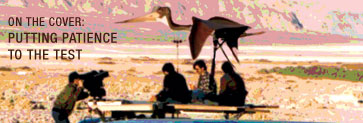
By Jessica Simmons
Most of my late-August evenings were spent watching American gymnasts compete in the Summer Olympics. The amount of flexibility, dedication, focus, stamina — and pure bravery — was fascinating to me.
I guess it’s the idea of putting oneself in harm’s way for a shot at hard-earned perfection, the ultimate goal being a medal not only for yourself, but for your team. I had previously wondered how this issue’s article would begin, but then I watched one of the gymnasts on the balance beam dismount with conviction, smile, wave at the crowd, laugh and hug her teammate who was up next, and then shake her head at her coach as if to say, “I could have done better.” I watched her focus, perform, and then respond appropriately to each of the people around her. It occurred to me that this is the type of balance that it takes to be a project leader: knowing how hard to push, knowing when to laugh, knowing how to motivate, and knowing what to do better next time.
In this issue, ASK writers explore ways to maintain that balance in their field of Project Management, and even what happens when they don’t. From his own experiences, Colby Africa learned that pushing too hard can take a personal toll, even though his project was a success in the end. He looked back and asked himself, “At what personal cost?”
Sometimes one of the most simple — and the most human way — of keeping oneself grounded is not to lose your sense of humor. Ray Morgan’s story about a test flight gone bad tells how the sound of their model crashing to the ground was followed by the test team’s hysterical laughter. The story, you will see, is much deeper. But the message in the example? Sometimes for no fault of our own, things just don’t go as planned. One way of dealing with it is to be able to laugh at ourselves. Of course, a setback itself is not to be taken lightly, but a leader capable of lightening the moment is more likely to set a positive tone for the try, try again.
Staying optimistic is important for team morale, specifically when a project is dealt a huge downsizing blow. After his project was cut significantly, Tom Sutliff was able to show his team that all was not lost and to help them focus on the fact that they still had a job to do. He had to balance the new project requirements with the fact that his team had been committed to the original project and would be personally affected. He stood back, got a new perspective, and upheld the positivity needed to lead them effectively.
Even when you keep your chin up and work to the best of your ability, things still go wrong. It’s human nature. People train for years to make it to the Olympics and blow their shot during one crucial second in the spotlight. For Marty Davis, his crucial second was when the contractor dropped his 3,000-pound spacecraft. Rather than point the finger at those around him, Marty stood up like a true leader and acknowledged what he could do better if ever in this situation again.
The other day I read a quote that said something about a real leader needing a “backbone, a funny bone, and a wishbone.” The “bones” are representative of the human factors of leadership: courage, conviction, and perseverance, a sense of humor and the ability to not take oneself too seriously, and hope, optimism, and a positive drive. In this issue, the writers tell their stories about balancing these factors — along with the necessary Project Management skills, training and experience — a leadership fundamental absolutely worthy of our attention.








